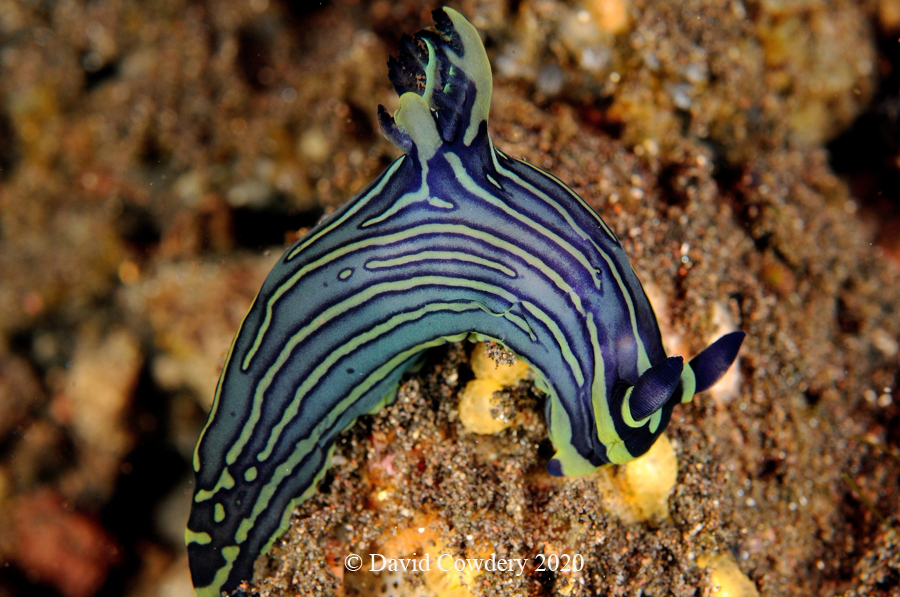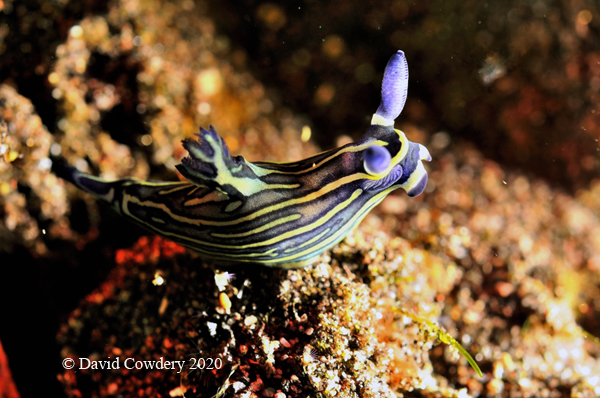 |
Image courtesy of David Cowdery
The Ledge, Sangeang, Indonesia
|
Image courtesy of David Cowdery Bontoh Village Sangeang,Indonesia  |
Tambja cf. sp. 3 (in NSSI 2nd edition)
Marta Pola and company in their 2005 and 2006 papers have cleared up many of the confusing Tambja species and added a few new ones. This species still remains undescribed. David had originally identified this critter as Tambja victoria, but there are numerous differences which disqualify that ID, most notably the three yellow-orange strips on the body and yellow rings at the base of the rhinophores. This undescribed Tambja has numerous green longitudinal body stripes, a few of which may be broken, and green rings around the base of the rhinophores. The gill, too is yellow green anteriorly. Nice pics David. Reference(s): Pola M., Cervera J.L. & Gosliner T.M. 2005. Four new species of Tambja Burn, 1962 (Nudibranchia: Polyceridae) from the Indo-Pacific. Journal of Molluscan Studies, 71(3): 257-267 Pola M., Cervera J.L. & Gosliner T.M. (2006) Taxonomic revision and phylogenetic analysis of the genus Tambja Burn, 1962 (Mollusca, Nudibranchia, Polyceridae). Zoologica Scripta 35(5):491-530. |
Dave Behrens
Sammamish, WA 98074
Jul., 2020
Send Dave Behrens email at davidwbehrens@gmail.com

Dave Cowdery is a retired bio-medical Engineer and is the inventor of the Alumina/Titanium hermetic feedthrough (1970) for implantable bionics and the first to introduce a Titanium casing. This invention created the first bionic implant (pacemaker) with a service life that could be measured in years rather than months and is the basis for todays huge multi billion dollar bionic industry. David is a Divemaster with over 5,500 dives experience and is based near Byron Bay in Australia. David is also a keen competitive road bicycle rider covering over 400 km most weeks. Photographic equipment used Nikon D800 camera with DS160 substrobes.
Send Dave mail at divec@ozemail.com.au
|

Attention all you Sluggers, and you know who you are! The NSSI 2nd edition is now available in ebook PDF and book form . The hard back version will become available Nov. 1st. Both will cost $65 (individually). You will need to jump through a few hoops to get the electronic version as pdf distribution is protected by Adobe ID!! Please read the following to enable reading your electronic purchase! This new 2nd Edition is updated and reorganized, including 185 new species. Among other features, the new edition includes additional photographs of species, an identification key, and an up-to-date classification reflecting the latest evolutionary relationships. The Indo-Pacific represents the largest expanse of tropical ocean in the world, stretching from the Indian Ocean coast of southern Africa and the Red Sea to the central Pacific of the Hawaiian Islands, Easter Island and the Marquesas. This region supports the most diverse marine fauna of any place in the world for most groups of marine organisms. The nudibranchs and sea slugs are no exception to this rule; there are about 3,000 described species of these organisms in the world and at least 40% of these have been found exclusively in the Indo-Pacific tropics. This book illustrates 2,138 Indo-Pacific nudibranchs and sea slugs, including many undescribed species.
|

|
